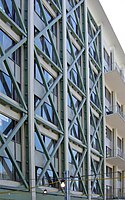
Photo from wikipedia
Abstract Model-updating hybrid tests were conducted to reveal the seismic behaviour of a typical reinforced-concrete (RC) rigid-frame thin-walled tall pier bridge. The bottom of the left pier was isolated and… Click to show full abstract
Abstract Model-updating hybrid tests were conducted to reveal the seismic behaviour of a typical reinforced-concrete (RC) rigid-frame thin-walled tall pier bridge. The bottom of the left pier was isolated and experimentally tested in a laboratory as a physical substructure (PS) and the rest of the bridge was simulated as a numerical substructure (NS). The parameters of the concrete constitutive model were identified online based on the experimental data of the PS and refreshed to the NS to correct their values during the test. Then, test results of the PS, involving crack developments and the failure mode, were obtained and compared to other quasi-static tests. Moreover, the high-order effect was analysed based on the verified NS data. Finally, a method to predict the failure mode of bridges with thin-walled tall piers is presented in view of the phenomenon that such bridges are prone to shear-dominant brittle failure. In this method, new formulas of aspect ratio are proposed in both a broad and a narrow sense by considering the thin-walled effect and high-order modes. The newly proposed method was then used to predict the failure mode of the target bridge pier and the piers provided by other tests. The results show that the failure modes predicted by the proposed method are consistent with that observed from the tests.
Journal Title: Engineering Structures
Year Published: 2020
Link to full text (if available)
Share on Social Media: Sign Up to like & get
recommendations!